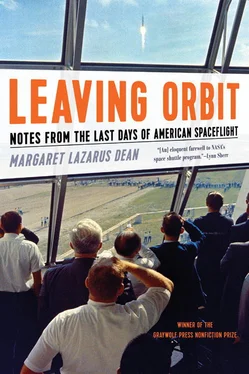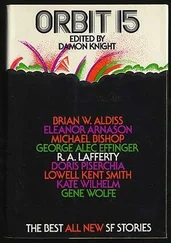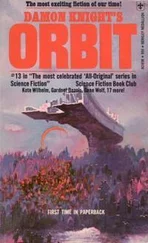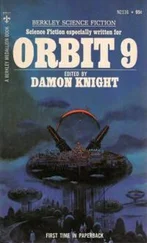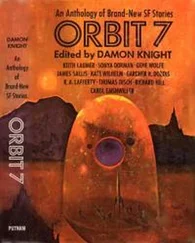Of course, part of the plan for getting to the moon involved building a moon port. The facilities at Cape Canaveral Air Force Station were not going to be adequate—not for the size of the new rockets themselves; not for the numbers of people necessary to take part in assembly, maintenance, and launch control; not for the number of launches that would have to be prepared simultaneously. In 1962, NASA chose a site nearby on Merritt Island, the landmass just to the west of Cape Canaveral, and began acquiring the land and designing the facilities. Mission Control would be housed at a facility near Houston first called the Manned Spaceflight Center, later renamed for President Lyndon Johnson after his death in 1973. Kennedy visited Cape Canaveral on November 16, 1963, and was shown around by Wernher von Braun and other NASA luminaries. He looked over the new Saturn rocket and the new moon port with excitement. Kennedy then flew from Florida to Dallas, where he was shot to death six days later.
Historians have debated why Kennedy chose to put so much of his political currency into Apollo. After all, he had shown little indication of caring about spaceflight before Sputnik, and even after Gagarin’s flight he seemed reluctant to make spaceflight a national priority. The most convincing discussion I’ve read is from historian John Logsdon, who argues that what caused Kennedy to make his decision was (1) “a conviction of American exceptionalism,” (2) the geopolitical situation of the moment, and (3) JFK’s individual values and style.
The day before he died, Kennedy gave a speech at the dedication of the nation’s first aerospace medical health center, in San Antonio. He reiterated how important the moon project was, in spite of the risks:
Frank O’Connor, the Irish writer, tells in one of his books how, as a boy, he and his friends would make their way across the countryside, and when they came to an orchard wall that seemed too high and too doubtful to try and too difficult to permit their voyage to continue, they took off their hats and tossed them over the wall—and then they had no choice but to follow them.
This Nation has tossed its cap over the wall of space, and we have no choice but to follow it.
Back at home, I have hanging over my desk an image of the Kennedy Space Center as it looked in 1963, girders rising improbably out of the surrounding swamp. The wetland had been drained, then tons of sand packed into the earth to make it stable enough for the construction of the world’s largest building. Workers who came out to pack the sand and drive the pilings found themselves covered with mosquitoes; many witnesses describe a white shirt turning black with blood-sucking insects within minutes. Histories of the Kennedy Space Center acknowledge without exaggeration that the obstacle posed by the mosquitoes was so serious that NASA quite literally could not have put a man on the moon by Kennedy’s “before the decade is out” deadline without the invention of DDT. In this way, the challenges of spaceflight reveal themselves to be distinctly terrestrial.
* * *
When the Vehicle Assembly Building was finally completed, NASA invited Life magazine to do a spread about the new moon port. Life photographers were given full access to the grounds, where they shot images of the largest building in the world from every angle. After returning home and processing thousands of photos, the photographers admitted that they had failed. They had not found a way to capture, in a single frame, the outsize scale of the VAB. One photographer tried to convey how large it was by photographing a man standing next to the building, but at the distance necessary to get the entire building into the frame, the man had disappeared, smaller than the grain of the film. The size of the Vehicle Assembly Building was officially unphotographable.
After the last successful Gemini mission, in 1966, the next step was to test the new Apollo-Saturn, the largest rocket ever built. Three astronauts were training for the first Apollo mission to fly with a crew. On January 27, 1967, they were doing a rehearsal at Cape Canaveral when a fire broke out in the sealed crew capsule on the launchpad. Gus Grissom (the second American in space), Ed White (the first American to ever do a space walk), and Roger Chaffee (who was training for his first spaceflight) all died in the fire.
Not long before, Italian journalist Oriana Fallaci had interviewed many of the astronauts and had asked them about the risk. John Glenn, whom Fallaci took a special liking to as “the most perfect fantastic Boy Scout in a nation of Boy Scouts,” spoke eloquently about the risks:
Up to today it has cost us little: only work and money. So many men went, so many came back. But it won’t always be like this, I know, we know. Some of us will die, maybe a whole crew will die: but remember, it’s worth it all the same. And because it’s worth it, we will accept our losses and continue with those who remain…. Yes, we must go up there, we must. And one day those who are against it will look back and be pleased at what we’ve done.
The Apollo 1 fire made the risks of spaceflight seem real to Americans for the first time—up to that point, nothing had ever gone seriously wrong, and it had started to seem as though the exploration of space would be without human cost. NASA recovered quickly from the setback, but future disasters would take greater tolls. Some space fans suspect Americans had a greater tolerance for risk in the sixties than we do now, but it may be that this first disaster seemed like an anomaly. A second (Challenger) seems like a betrayal; a third (Columbia) seems like a pattern of failure.
The Vehicle Assembly Building was designed to house the simultaneous assembly of four moonbound rockets, and as such it stands as a monument to a long-past era in American history. There never did come a time when four Saturn V rockets were assembled at once. The history of American spaceflight is a history of doing less than had been planned, less than had been hoped for. Space fans angry about the end of the shuttle seem to think that their disappointment is something new, but in fact the dreams of space enthusiasts have been scaled back from the start. A lunar base, a permanent space station, a reusable spaceship with a booster section that could land like an airplane, a Mars expedition—all these were to have been undertaken by the eighties. Not only were the new projects tabled, but the last three Apollo missions were scrapped before the third crew of moonwalkers landed.
* * *
Family Day is a Kennedy Space Center tradition that began in the mid-1960s, when spaceworkers’ families complained that they had no idea what went on behind the gates, what was keeping their spouses and parents so frantically busy for so many hours and so distracted even when they were at home. Certain Saturdays were established when workers could bring their families inside the gates and show them around. Family Days decreased in frequency after the debut of the space shuttle, with its more dangerous solid rockets. And after the terrorist attacks of 2001 led to heightened security at government facilities, Family Days stopped altogether. But now that the retirement of the shuttle is within sight, there is a last-chance feeling around the Kennedy Space Center, and a few final Family Days will be held before the end. Today is one of them.
My first contact with Omar Izquierdo was in 2007, when he sent me the first e-mail I received about my Challenger novel, the day after its official publication date.
From: Omar Izquierdo
Subject: Comments about your Book, The Time It Takes to Fall
To: Margaret Lazarus Dean xxxxxxxxxxx@gmail.com
Читать дальше
